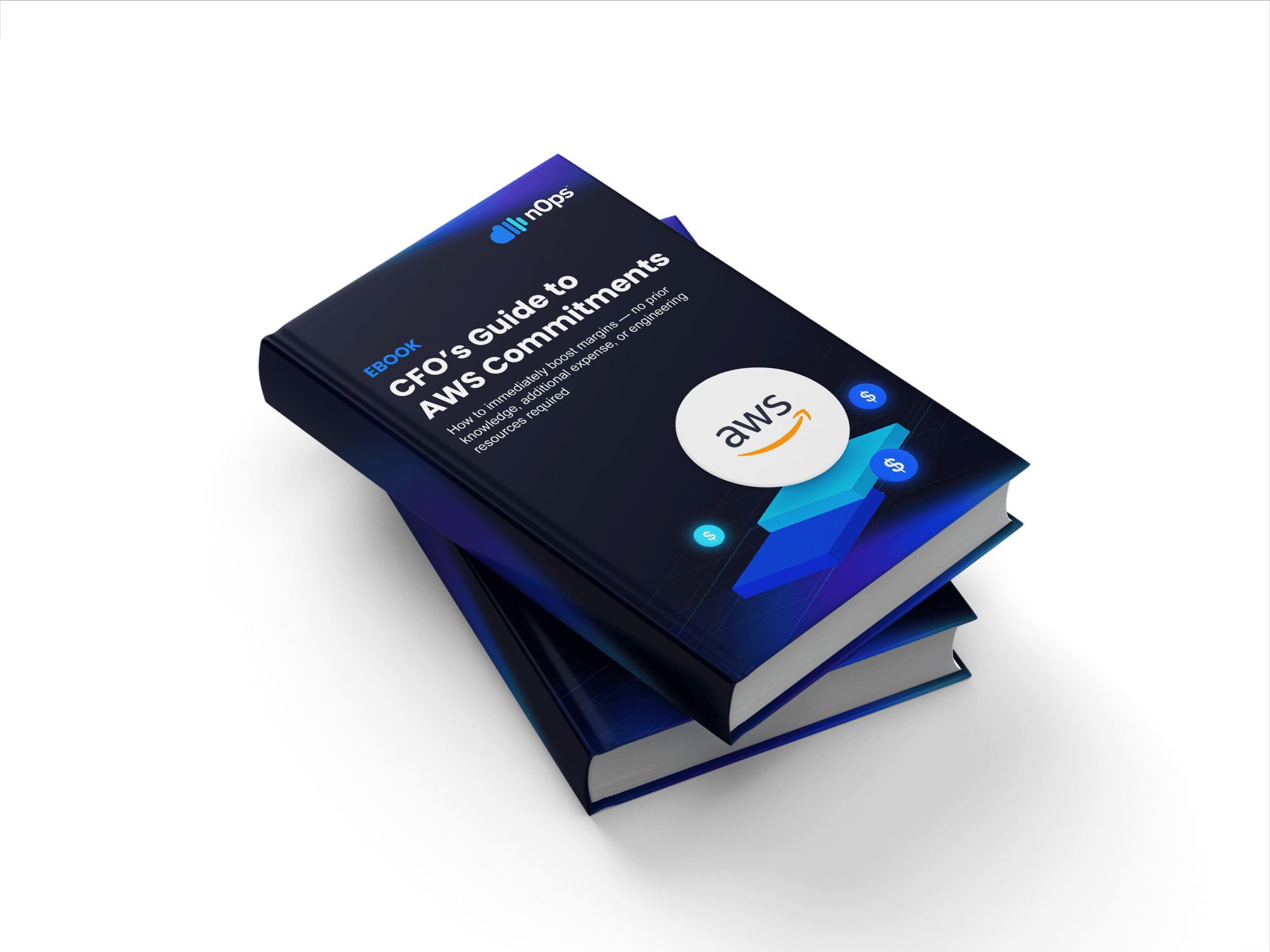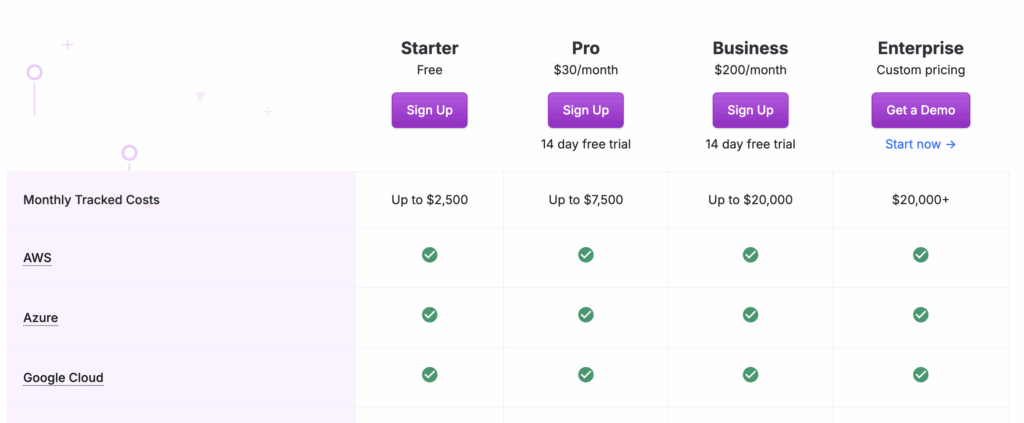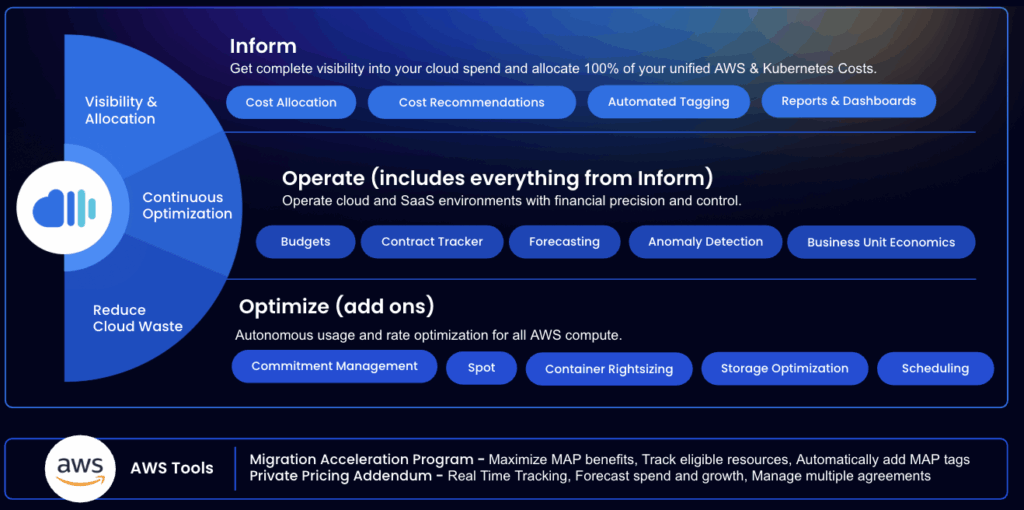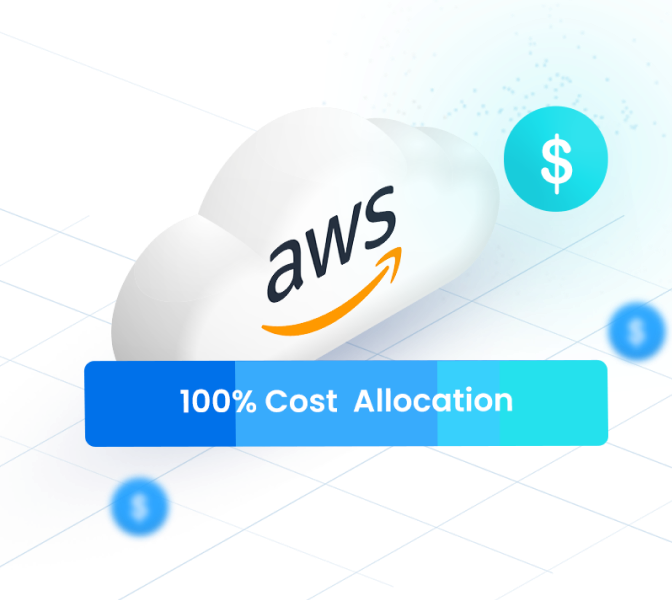- Blog
- Cloud Management
- Vantage Pricing Explained: How It Works & How To Optimize
Vantage Pricing Explained: How It Works & How To Optimize
Last Updated: August 18, 2025, Cost Management
Vantage is a self-service cloud cost visibility platform that helps teams track and analyze spend across AWS, Azure, GCP, and other services. Its straightforward pricing model is based on total monthly tracked cloud costs, with unlimited users included at every tier.
In this guide, we’ll break down Vantage’s pricing structure, what each tier offers, and where it fits compared to other FinOps platforms for getting visibility into your cloud costs.
How Vantage Approaches Pricing: The Basics
Vantage uses a simple monthly subscription model with tiers based on the amount of cloud spend you track, not on the number of users. You can pay via credit card through Stripe or route billing through AWS or Azure Marketplace. Autopilot, Vantage’s optimization feature, is priced separately at 5% of the savings it generates.
The advantage of this approach is its clarity there are no per-seat fees or complex usage-based billing for core features, and costs scale in clear steps as your tracked spend grows. The downside is that tier jumps are steep if your future cloud spend increases, and the separate Autopilot fee means optimization can add to your total cost.
In sum:
- Monthly subscription model based on tracked cloud spend, not seats.
- Option to pay via Stripe, AWS Marketplace, or Azure Marketplace.
- Separate fee for optimization
Starter (Free)
Starter is capped at $2,500 in tracked monthly spend. It’s basically a no-cost way to centralize cost data across AWS, Azure, GCP, Kubernetes, and other supported integrations like Datadog, Snowflake, and other SaaS tools. You get core features like cost reports, dashboards, budgets and forecasting, but no Autopilot optimization. Support is best-effort via email plus access to Vantage’s Slack community.
If you’re running a side project, testing workloads, or just want a lightweight reporting layer on a small account, Starter covers the basics.
Pro ($30/month)
Pro bumps the tracked spend limit to $7,500 and unlocks Autopilot, Vantage’s commitment-buying feature for AWS EC2. Autopilot is priced separately at 5% of savings. Pro also comes with same-day email support and a monthly bill review to help catch anomalies or cost spikes. This level is best for teams with relatively low AWS spend that want a lightweight tool for basic cost visibility.
Business ($200/month)
Raises the tracked spend cap to $20,000. Includes Autopilot under the same 5% savings fee model, plus Kubernetes efficiency metrics for analyzing container resource usage. Business also adds a dedicated account representative and retains same-day email support with the monthly bill review. RBAC (role-based access control) is not included here—that’s reserved for Enterprise. The spend cap increase and additional account management are the main differences from Pro.
Enterprise (Custom)
Anything over $20,000 in tracked spend falls into Enterprise. Pricing can be a percentage of your spend metered monthly, or a fixed-rate annual contract with a 12-month minimum. Enterprise includes every available feature, unlimited connected accounts, RBAC, premium support, and negotiable items like Kubernetes efficiency metrics. Autopilot is included here too, still billed at 5% of savings. This tier is about having the most flexible procurement and support arrangements.
While Vantage supports enterprise customers, in practice, most large enterprises opt for more complete FinOps platforms (such as nOps or CloudZero) for their deeper visibility capabilities—such as more granular cost allocation, richer context for spend drivers, and advanced filtering—especially when managing complex multi-cloud or business-unit-level reporting needs.
How Vantage Enforces Tier Limits & Cloud Costs
Vantage enforces tier limits based on the total accrued costs from the previous month. For example, in February, your limits would be determined by the total costs across all connected accounts in January.
Feature List & User Interface Comparison
Feature | Vantage | CloudZero | CloudHealth | nOps |
Visibility | ||||
Cost Allocation | ✅ | ✅ | ✅ | ✅ |
Automated Tagging | ✅ | ✅ | ✅ | ✅ |
Budgets & Cost Tracking | ✅ | ✅ | ✅ | ✅ |
Customizable Reports & Dashboards | ✅ | ✅ | ✅ | ✅ |
Break down costs by any Kubernetes concept | ✅ | ✅ | 🚨 (limited; no deep native Kubernetes support) | ✅ |
Break down costs by any Finance concept | 🚨 | ✅ | ✅ | ✅ |
Kubernetes Costs Unified with All Spend | ✅ | ✅ | 🚨 | ✅ |
Forecasting, Cost Anomalies & Alerts | ✅ | ✅ | ✅ | ✅ |
AI FinOps Agent | ✅ | ✅ | 🚨 | ✅ |
Integrations for AWS, GCP, Azure, SaaS | ✅ | ✅ | ✅ | ✅ |
Savings Recommendations | ✅ | ✅ | ✅ | ✅ |
Commitment Management | ||||
Recommendations for Reserved Instances & Savings Plans | ✅ | ✅ | ✅ | ✅ |
Fully automated management of RI & SP | ⚠️ (SP only) | 🚨 | 🚨 | ✅ |
Commitment monitoring & visibility | ✅ | ✅ | ✅ | ✅ |
100% Utilization Guarantee (or full refund of unused portion, subject to terms & conditions) | 🚨 | 🚨 | 🚨 | ✅ |
EKS Observability & Management | ||||
Native integration with Karpenter or Cluster Autoscaler | 🚨 | 🚨 | 🚨 | ✅ |
Spot Market Monitoring | 🚨 | 🚨 | 🚨 | ✅ |
Intelligent Instance Selection | 🚨 | 🚨 | 🚨 | ✅ |
Graceful Pod Rebalancing | 🚨 | 🚨 | 🚨 | ✅ |
Real-time Workload Reconsideration | 🚨 | 🚨 | 🚨 | ✅ |
Same reliability SLAs as AWS On-Demand | 🚨 | 🚨 | 🚨 | ✅ |
Container Rightsizing Recommendations | 🚨 | 🚨 | ⚠️ Basic rightsizing insights | ✅ |
One-click Automated Container Rightsizing | 🚨 | 🚨 | 🚨 | ✅ |
Deep Container & Node Efficiency Visibility | ✅ | ✅ | 🚨 | ✅ |
AWS-Certified Spot Partner | 🚨 | 🚨 | 🚨 | ✅ |
Cloud Optimization & Automation | ||||
Automated Resource Rightsizing | ⚠️ (Recommendations only) | 🚨 | ⚠️ (Recommendations only) | ✅ |
Automated EBS Optimization | 🚨 | 🚨 | 🚨 | ✅ |
Automated Resource Scheduling | 🚨 | 🚨 | 🚨 | ✅ |
AWS Tools | ||||
AWS Migration Assistance Program (MAP) Tracker | 🚨 | 🚨 | 🚨 | ✅ |
AWS EDP / PPA Tracker | 🚨 | 🚨 | 🚨 | ✅ |
Cloud SaaS Tracker (Datadog, Databricks, etc.) | 🚨 | 🚨 | 🚨 | ✅ |
AI Tools | ||||
AI Model Provider Recommendations | 🚨 | 🚨 | 🚨 | ✅ |
Buying Through AWS Marketplace: What to Know
Vantage is available through the AWS Marketplace, but the onboarding flow creates friction. Because entitlements are tied to your AWS Organization ID, the Vantage application won’t unlock until that linkage is fully processed. Accepting the Marketplace offer triggers an entitlement event from AWS, but until Vantage’s backend receives and reconciles that event, the product remains inaccessible. In practice, this means some customers experience a lag—sometimes up to two days—before usage data becomes visible.
Another limitation is how the free tier works. Vantage’s Starter plan is capped at $2,500 in tracked monthly spend. If your cloud costs exceed that, the free tier is no longer available, and any Marketplace subscription begins with a paid plan.
nOps takes a different approach. A free tier is available directly through the AWS Marketplace, and setup does not require waiting for Organization ID entitlements to propagate. Customers can connect accounts and start seeing cost data right away, without delays or mandatory Marketplace billing just to get started.
Strengths & Trade-Offs of the Pricing Model: Actual Usage Charges & Seat-Based Pricing
Let’s sum up the pros and cons.
Strengths | Trade-Offs |
Predictable monthly cost makes budgeting simple. | The platform is self-service with a narrow feature set compared to full FinOps platforms. |
Unlimited seats at all tiers with no per-user fees. | Autopilot’s 5% fee based on actual usage adds additional costs for optimization use cases. |
No usage-based charges for core features. | Tier jumps can be steep if your cloud spend grows quickly. |
Can support small teams. | May require supplemental tools for deeper visibility or automation. |
When to Consider Vantage Alternatives
Vantage is best suited for teams that only need cost visibility. It’s lightweight with a self-service user interface, but its capabilities stop at reporting: savings recommendations require manual action, Kubernetes visibility lacks efficiency benchmarking, and commitment automation is limited to basic Savings Plan purchases.
nOps builds on the same visibility foundation but goes further—automating optimization across commitments, compute, storage, and containers. It not only shows waste but removes it, with flat pricing instead of usage-based fees. That keeps costs predictable as your environment grows while savings continue to compound.
nOps also provides both a free trial and a free tier, regardless of spend. The free tier includes tools like the MAP Tracker, optimization opportunity discovery, and cost explorer with 15+ dimensions—valuable for anyone looking to understand and manage cloud spend.
nOps was recently ranked #1 with five stars in G2’s cloud cost management category, and we optimize $2 billion in cloud spend for our customers — book a demo to explore the capabilities with your own AWS account.





